Chapter 1:
UNDERGRADUATE STUDENTS: ADMISSIONS and ENROLLMENT
California resident enrollment increases, new transfer enrollees increase slightly
UC enrolled the largest-ever incoming class of California resident undergraduates in fall 2023, directly in line with the University’s proposal to grow this population by 17,000 to 23,000 between 2020–21 and 2029–30. In 2023–24, UC plans to meet legislative expectations for growth by increasing California resident undergraduate FTE by 7,800 compared to 2021–22. To reach the proposed 2029–30 goal, enrollment of undergraduate California residents is estimated to grow around one percent per year on average from 2024–25 through 2029–30.
One of the university’s highest priorities is to ensure that a UC education remains accessible to all Californians who meet the admissions standards. This goal is articulated in California’s Master Plan for Higher Education, which calls for UC to admit all eligible freshmen and transfers, with freshman eligibility designed to capture the top 12.5 percent of California public high school graduates. Campus admission decisions are based on a comprehensive review of qualifications and establish the incoming California resident class size based on state funding.
The rapid growth in freshman applications to UC from 48,800 in 1994 to 206,900 in 2023 demonstrates the increased demand for a college education, the growth of California’s population, and UC’s continued desirability. UC continues to meet its Master Plan goals of guaranteeing admission to California resident applicants who are either in the top nine percent of high school graduates statewide or the top nine percent of graduates from their own high schools. Qualified freshman applicants are offered an opportunity to be admitted to another UC campus if they do not receive an offer of admission from any of the UC campuses where they applied.
Fall transfers applications have grown from 19,900 in 1994 to 39,800 in 2023. Consistent with UC’s commitment to transfer students from California Community Colleges (CCCs), enrollment of new CCC California resident transfers more than doubled since 1994, from 8,400 to 19,600 in 2023. Almost all transfer students enter UC at the upper-division with junior status. Campus enrollment targets are based on state funding as well as capacity in major programs. Transfer applicants and admits decreased slightly and enrollees increased very slightly in fall 2023 as CCC enrollments continued to be below past levels. This has made it difficult for some UC campuses and the UC system to achieve the goal of enrolling two new California resident freshmen for every one new California resident transfer.
UC Transfer Pathways (UCTPs) identify a common set of lower-division courses for each of 20 of the most popular majors. UCTPs present a roadmap for prospective transfers to prepare for their majors and be well positioned to graduate in a timely fashion from any UC campus. Expanding on the campus-based Transfer Admission Guarantees (TAGs), Pathways+ is an option for those who want both guaranteed admission to a TAG campus in a particular major while also preparing for admission to all campuses with that major. For more information, see: admission.universityofcalifornia.edu/admission-requirements/transfer-requirements/uc-transfer-programs/.
The remainder of this chapter provides indicators in four areas:
- 1.1 Applicants, admits, and enrollees
- 1.2 Demographic outcomes
- 1.3 Preparation outcomes
- 1.4 Geographic origins and nonresidents
Demand for UC admission from freshman remains high.
1.1.1 Freshman applicants, admits, and enrollees, Universitywide and UC campuses, Fall 1994 to 2023
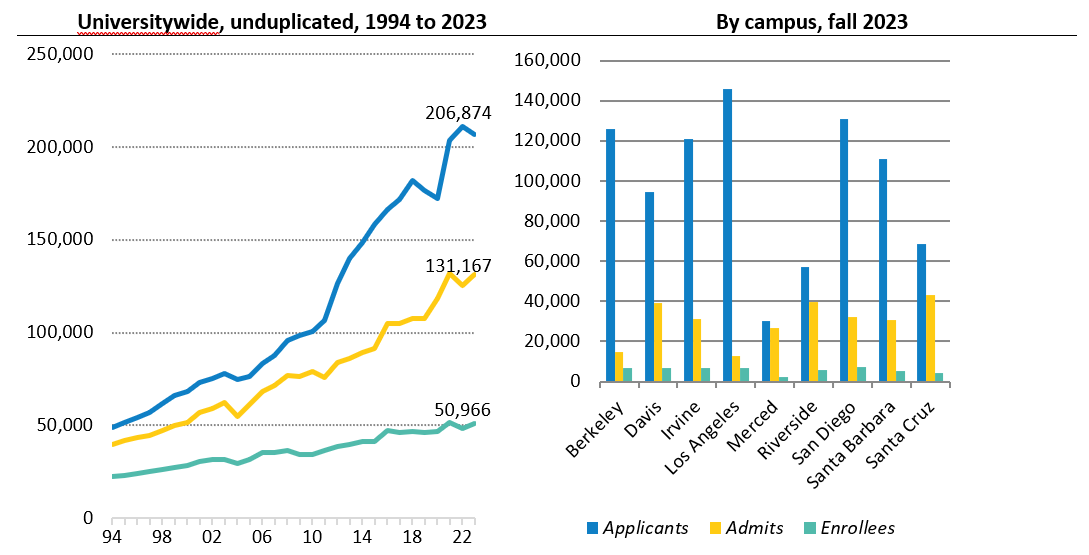
source: UC Data Warehouse
After increasing in 2021 and 2022, unduplicated freshman applicants decreased two percent from 2022 to 2023 to about 207,000. Total growth from 2013 to 2023 was about 67,000 applicants, including about 33,000 California residents.
In fall 2023, most campuses admitted less than half of freshman applicants. Freshman applications increased at four campuses and decreased at five campuses, and applicants applied to an average of 4.2 campuses.
The Undergraduate admissions summary dashboard at the UC Information Center presents data tables on UC freshman applicants, admits, and enrollees by campus over time.
Note: Admits and enrollees here include applicants guaranteed admission who are not offered admission at a campus to which they applied but who are referred to and admitted by another campus. Some campuses admit fall applicants for a subsequent term (winter or spring). These “rollover” admits and enrollees are excluded in this indicator. Students who apply to multiple UC campuses are counted only once in the Universitywide indicator. A change in accounting for referral students is responsible for the apparent drop in 2011 admits. Beginning that year, UC Merced admitted only students who indicated interest in a referral offer, rather than every student who qualified for an offer.
Transfer applicants and admits decreased and enrollees slightly increased in 2023.
1.1.2 Transfer applicants, admits, and enrollees, Universitywide and UC campuses, Fall 1994 to 2023

source: UC Data Warehouse
Transfer applications decreased by two percent and admits decreased by one percent, while enrollees increased by less than half a percent in fall 2023 compared to 2022. Almost all transfer enrollees (91 percent) came from California Community Colleges (CCCs). On average, transfer applicants applied to 3.6 UC campuses.
The Undergraduate admissions summary dashboard at the UC Information Center presents data tables on UC transfer applicants, admits, and enrollees by campus over time.
UC did not meet the 2:1 goal of resident freshman to transfer enrollees in 2023–24 due in part to a smaller applicant pool of California Community College transfer students.
1.1.3 New California resident freshmen and transfer students, Universitywide, 2008–09 to 2023–24
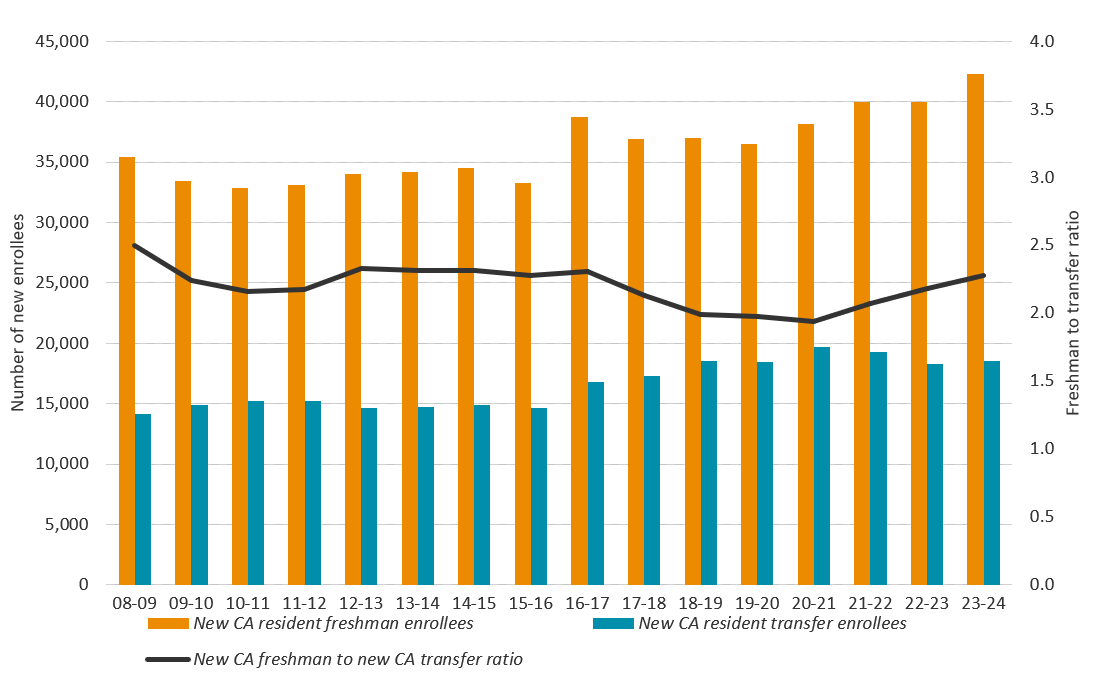
source: UC Data Warehouse and UC campuses
The California Master Plan calls for UC to accommodate all eligible resident California Community College (CCC) transfer students. It specifies that the University maintain at least a 60:40 ratio of upper-division (junior and senior) to lower-division (freshman and sophomore) students to ensure adequate upper-division spaces for CCC transfers. To do so, UC aims to enroll one new California resident transfer student for every two new California resident freshmen, or 67 percent new resident freshmen to 33 percent new resident transfer students. UC moved from 2.3:1 in 2016–17 to 1.9:1 in 2020–21 before increasing slightly the last two years to 2.2:1 in 2022–23 and 2.3:1 in 2023–24. The UC system and several UC campuses did not meet 2:1 in 2023–24 due in part to a smaller applicant pool of California resident transfer students as well as an increase in freshman admits. to achieve the state’s enrollment growth goal. The domestic California Community College transfer admit rate was 77 percent for fall 2023, 75 percent for fall 2022, and 71 percent for fall 2021.
|
2023–24*
|
% New CA resident freshmen
|
% New CA resident transfers
|
Ratio of new CA freshmen to new CA transfers
|
|
Berkeley
|
68%
|
32%
|
2.1
|
|
Davis
|
68%
|
32%
|
2.1
|
|
Irvine
|
67%
|
33%
|
2.0
|
|
Los Angeles
|
61%
|
39%
|
1.5
|
|
Merced
|
90%
|
10%
|
9.0
|
|
Riverside
|
78%
|
22%
|
3.6
|
|
San Diego
|
66%
|
34%
|
1.9
|
|
Santa Barbara
|
70%
|
30%
|
2.3
|
|
Santa Cruz
|
77%
|
23%
|
3.4
|
|
Universitywide, all campuses
|
70%
|
30%
|
2.3
|
|
Universitywide, excl. Merced
|
69%
|
31%
|
2.2
|
UC had its largest class of CA residents in 2023.
1.1.4 Undergraduate headcount enrollment, Universitywide and UC campuses, Fall 2008 to 2023
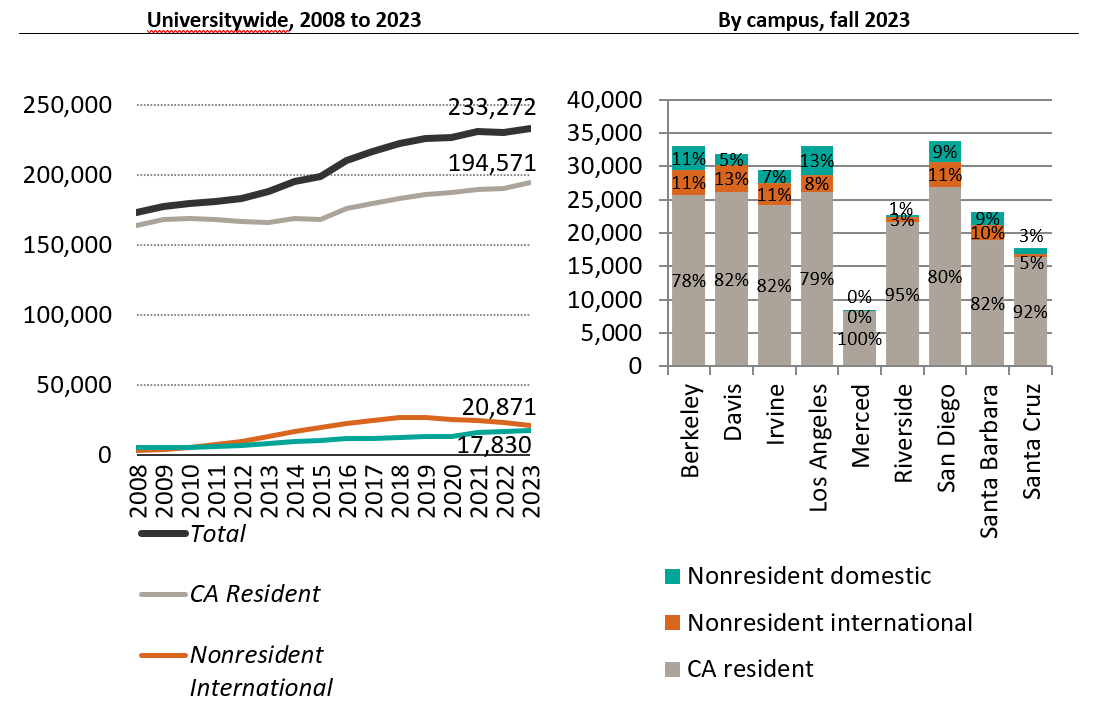
source: UC Data Warehouse
The University and the state share the goal of expanding access to a UC education. The University enrolled over 4,100 additional California residents in fall 2023 compared to fall 2022, with a total increase of over 26,000 California resident undergraduates since fall 2015.
1.1 APPLICANTS, ADMITS AND ENROLLEES
UC continues to make progress to UC 2030 capacity plan goals.
1.1.5 FTE enrollment, progress toward 2030 goals, Universitywide, 2015–16 to 2029–30
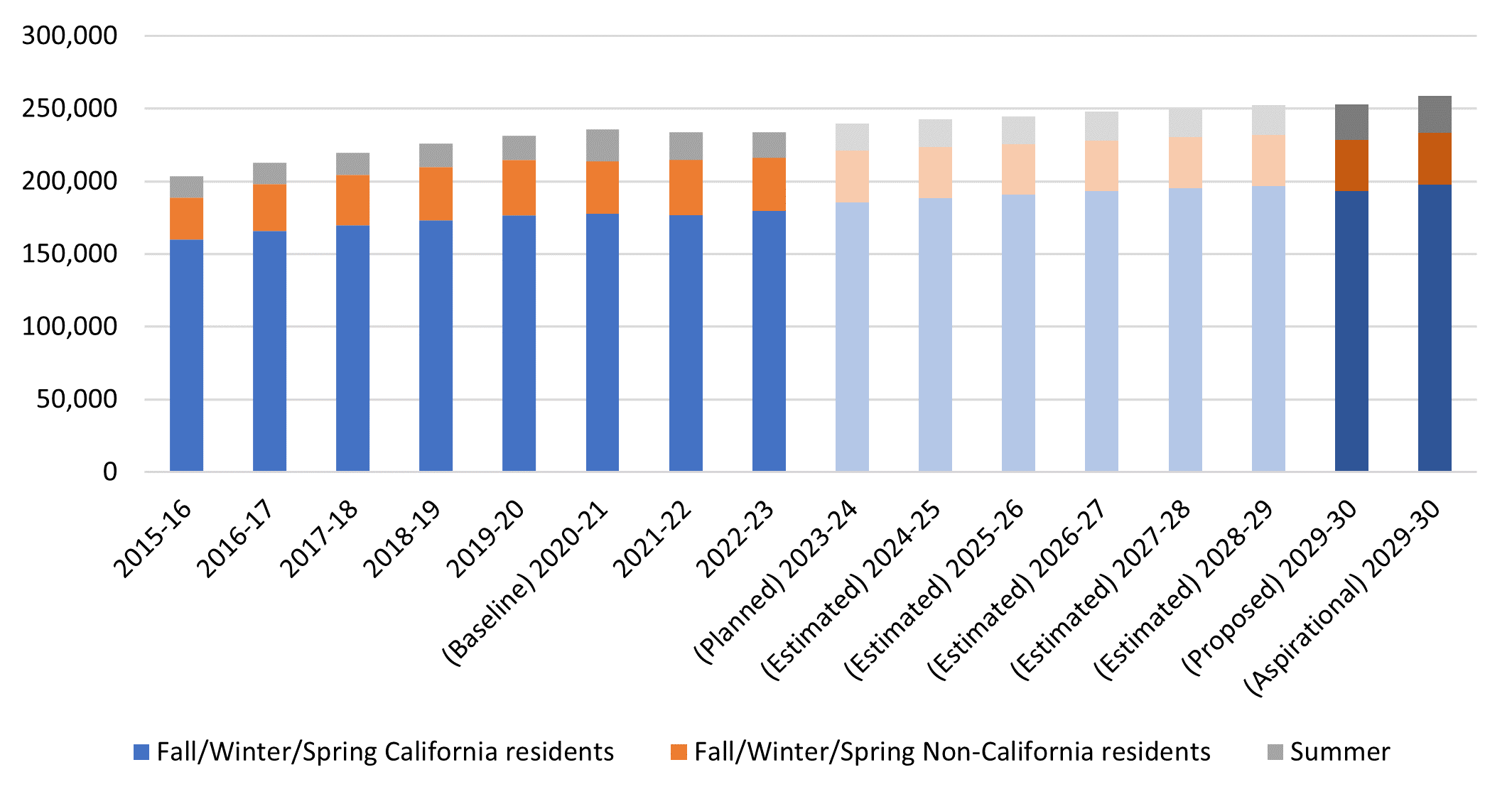
source: UC Data Warehouse, UCOP Institutional Research & Academic Planning
In the University of California 2030 Capacity Plan, UC proposed increasing undergraduate enrollment of California residents1 from about 200,000 in 2020–21 to between 217,000 and 223,000 in 2029–30 and reducing the proportion of undergraduate enrollment of non-California residents.
In 2023–24, UC plans to meet legislative expectations for growth by increasing California resident undergraduate FTE by 7,800 compared to 2021–22. To reach the proposed 2029–30 goal, enrollment of undergraduate California residents is estimated to grow around one percent per year on average from 2024–25 through 2029–30.
1In this capacity plan, summer students are counted as California residents.
A little over one-third of entering freshmen and over two-fifths of entering transfer students are first-generation college students.
1.2.1 Entering students by first-generation status, Universitywide, Fall 2011 to 2023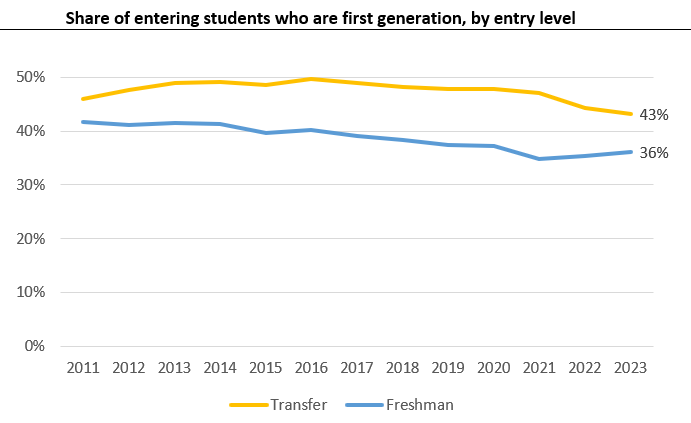
source: UC Data Warehouse
Just over one-third (36 percent) of entering freshman students were first generation in fall 2023 compared to 43% of entering transfers. The first-generation share of freshmen was up slightly from 35 percent in fall 2022 while the share of transfer students declined slightly from 44 percent in fall 2022.
Note: First-generation students are those whose parent(s) did not complete a four-year college degree. Total of first-generation students is 26,840 (38 percent); not-first-generation students total 41,499 (59 percent); and missing/unknown are 2,214 (3 percent).
1.2 DEMOGRAPHIC OUTCOMES
Most undergraduate students who are first-generation are from underrepresented groups (URGs).
1.2.2 Demographics of first-generation students, Universitywide

First-generation college students dashboard
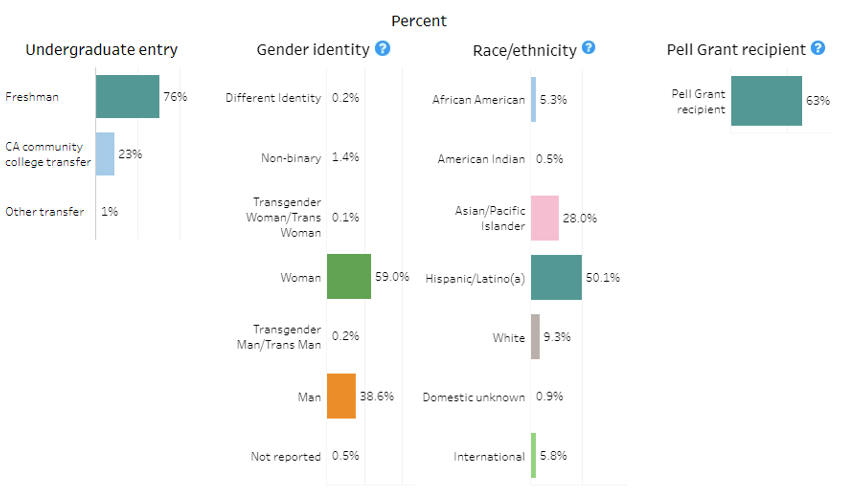
source: UC Data Warehouse
Over half (56 percent) of first-generation undergraduate students in fall 2023 are from URGs. Almost one-fourth (24 percent) of first-generation students entered as transfers. Over three-fifths (63 percent) of first-generation students are lower-income Pell Grant recipients. And nearly three-fifths (59 percent) of first-generation students are women vs. 39 percent men, and about two percent other gender identities or unknown.
Note: Pell Grant receipt is used as a proxy for low-income status. The other gender identities category includes Different Identity, Nonbinary Gender, Transgender Woman/Trans Woman, and Transgender Male/Trans Man.
1.2 DEMOGRAPHIC OUTCOMES
The gap between the share of URG high school graduates and URG freshman enrollees decreased slightly in 2023 to 20 percentage points.
1.2.3 Underrepresented Groups (URGs) as a share of California public high school graduates vs. the share of high school A-G completes, UC freshman applicants, admits, and new enrollees from California public high schools,Universitywide, Fall 1989 to 2023

Gap analysis dashboard
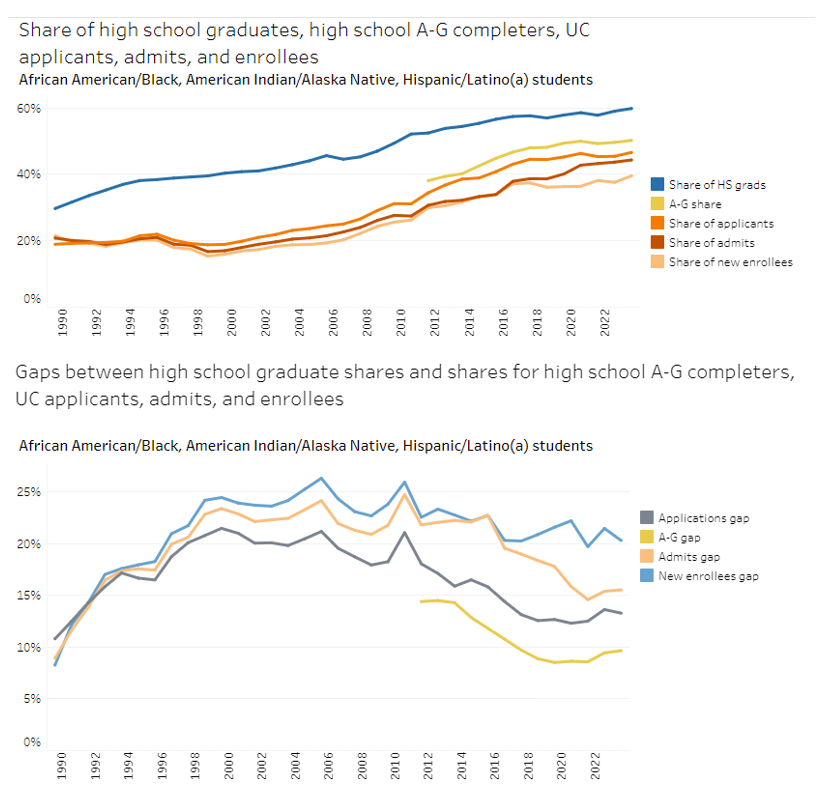
source: UC Information Center
Before Proposition 209 took effect in 1998, the gap between the share of URGs among CA public high school graduates and the share of URGs among UC freshman enrollees from CA public high schools was in the 8 to 22 percentage point range, with most years below 20 percentage points. This gap has stayed in the 20–26 percentage point range since 1998.
In 2023, 59.7 percent of California public high school graduates were from URGs, while 39.4 percent of new freshman enrollees at UC were from these groups, for a 20.3 percentage point gap (similar to the 20–22 percentage point gaps in recent years).
1.2 DEMOGRAPHIC OUTCOMES
The gap between the share of transfer ready CCC students who are from URGs and the share of CCC transfer new enrollees who are from URGs has grown in recent years.
1.2.4 Underrepresented Groups (URGs) as a share of transfer-ready1 California Community College (CCC) students vs. a share of UC transfer applicants, admits, and new enrollees from CCCs, Universitywide, Fall 1989 to 2023

Gap analysis dashboard
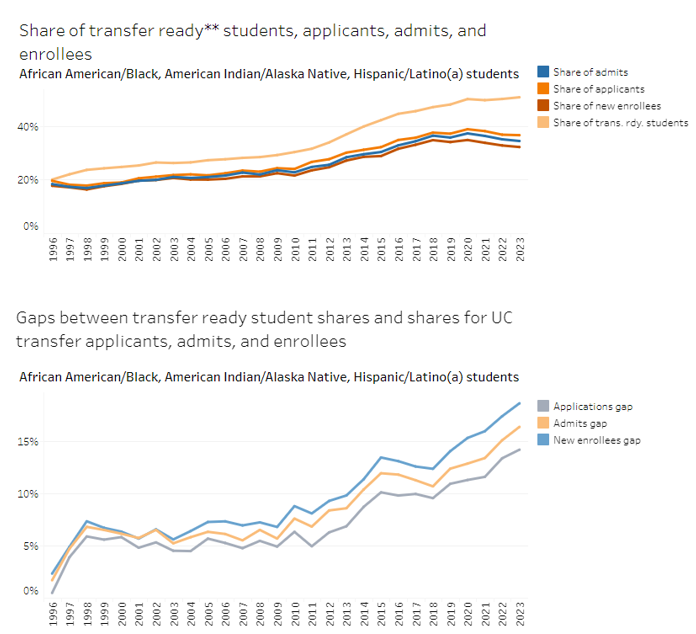
source: UC Information Center
The gap between the URG share of transfer ready CCC students and the URG share of UC transfer enrollees from CCCs has gone from 5.6 percentage points in 2003 to 18.6 percentage points in 2023.
Note: Transfer ready students may or may not meet criteria for UC transfer admission. Transfer ready students are those who have successfully completed a transferable English and a transferable math course and have earned 60+ transferable units with a 2.00+ GPA.
1.2 DEMOGRAPHIC OUTCOMES
Over one-quarter of dependent freshman applicants, admits, and enrollees had parents’ income under $50,000 in fall 2023.
1.2.5 Undergraduate freshman applicants, admits, and enrollees by self-reported parents’ income, Universitywide1, Fall 2012 to 2023

source: UC Data Warehouse
UC provides opportunity by enrolling an economically diverse student body, including a large number of low-income students. In fall 2023, over 80 percent of freshman applicants, admits, and enrollees were dependent, about 1 percent were independent, and the rest were unknown. In recent years, 28-29% of dependent freshman applicants, admits, and enrollees have had parents’ income under $50,000, 18-20% were between $50,000 and $99,999, 13-14% were between $100,000 and $149,999, and 38-40% were at least $150,000.
Notes:
- Dependency status and parental income are based on information reported on the application for admission, both of which can vary from that provided on financial aid applications. All dollar amounts are in inflation-adjusted 2023 dollars. The unknown category comprises students who did not provide income information on the application.
- To be considered independent, a student must be married, have children, be a member of the U.S. military on active duty or have served on active duty, or be age 24 by the time they enroll at UC. All others who provided income information are considered dependent. The increase in unknown dependency status in fall 2020 was primarily due to changes in the presentation of income questions on the application.
1.2 DEMOGRAPHIC OUTCOMES
Almost one-third of dependent transfer applicants, admits, and enrollees had parental income under $50,000 in fall 2023.
1.2.6 Undergraduate transfer applicants, admits, and enrollees by self-reported parents’ income, Universitywide, Fall 2012 to 2023
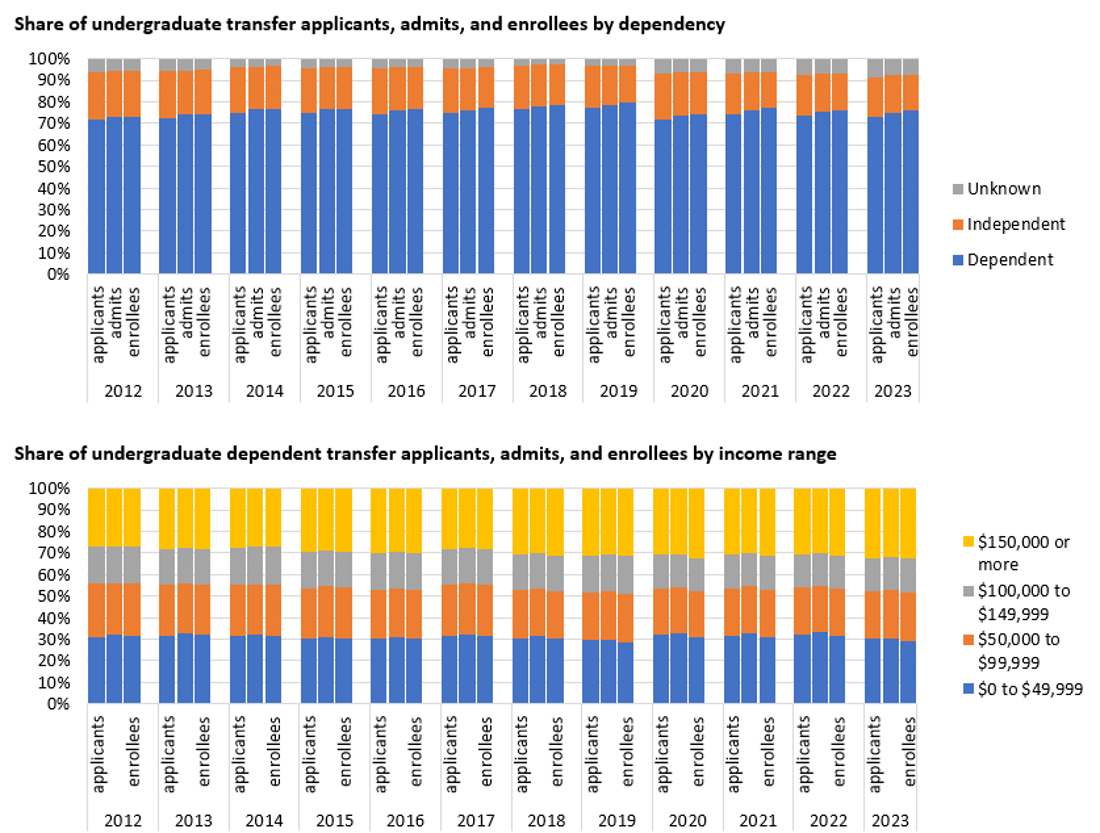
source: UC Data Warehouse
UC’s transfer students are economically diverse, including a sizable number of low income students. In fall 2023, about three-quarters (76%) of transfer enrollees were dependent. About one-sixth (16%) were independent, and the remainder (8%) were unknown.
Among dependent transfer enrollees:
- 29% had incomes under $50,000
- 23% were between $50,000 and $99,999
- 15% were between $100,000 and $149,999
- 33% were at $150,000 or above
Note: Dependency status and parental income are based on information reported on the application for admission, both of which can vary from that provided on financial aid applications. All dollar amounts are in inflation-adjusted 2023 dollars.
2To be considered independent, a student must be married, have children, be a member of the U.S. military on active duty or have served on active duty, or be age 24 by by the time they enroll at UC. All others who provided income information are considered dependent.
Freshmen entering UC are increasingly well prepared.
1.3.1 A–G (college preparatory) courses and weighted, capped high school grade point average (GPA) of entering freshmen, as share of class, Universitywide, Fall 2008 to 2023
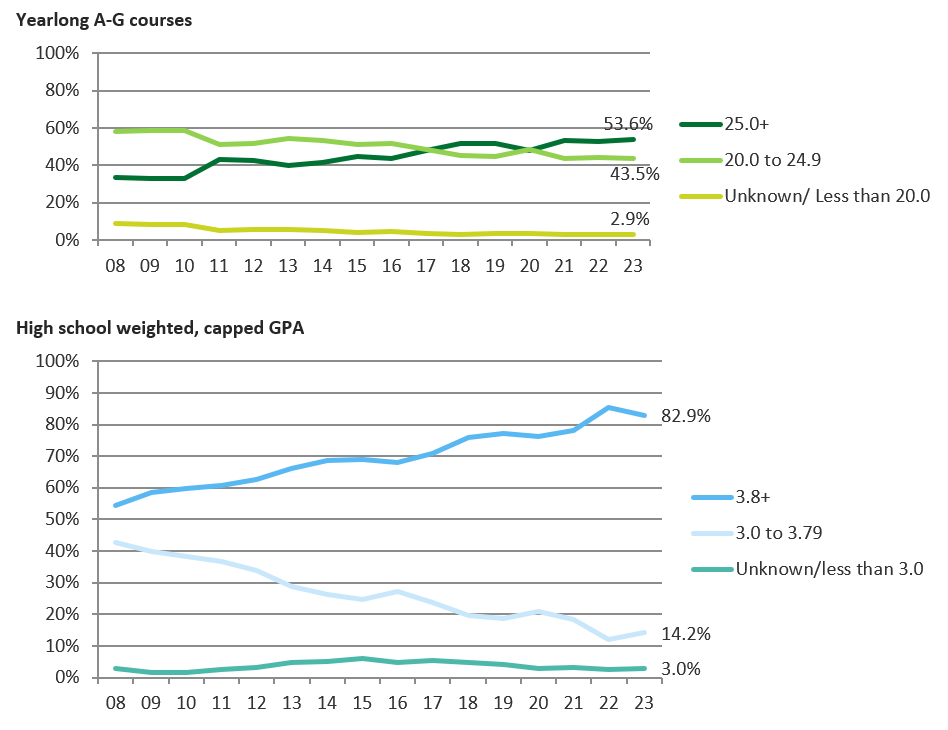
source: Apply UC data (A–G courses) and UC Data Warehouse (GPA)
From 2008 to 2023, the share of students completing 25 or more college-preparatory courses went up from 33 percent to 54 percent, while the share having a high school GPA of 3.8 or higher went up from 54 percent to 83 percent.
Notes:
- A–G courses refer to those high school courses that UC has reviewed and approved as college preparatory. The minimum number of required A–G courses is 15.
- Weighted, capped GPA means that students may receive a maximum of eight semesters of honors credit. More information is available at the UC Admissions website.
UC transfer students entering in fall 2023 performed better academically than their counterparts a decade ago, as measured by their grades in pre-UC college courses.
1.3.2 College grade point average (GPA) of entering transfer students, as share of class, Universitywide, Fall 2008 to 2023

source: UC Data Warehouse and UC Corporate Student System
The academic qualifications of transfer students entering UC have improved over time, as reflected by an increase in the share of students having a 3.6 or higher pre-UC college GPA, from 37 percent in fall 2008 to 60 percent in fall 2023.
Note: The transfer GPA is based on grades for college-level courses reviewed and approved by UC for transfer credit from the college(s)
where students were previously enrolled.
UC has consistently had a substantially lower proportion of out-of-state undergraduates than other AAU universities in recent years. In fall 2023, only 16.6 percent of UC’s enrollees were out-of-state or international, compared with 32.8 percent for other AAU Public institutions.
1.4.1 Residency of undergraduate students, Universitywide and comparison institutions, Fall 2023

source: UC Data Warehouse (UC numbers) and Common Data Set (comparator numbers)
Nonresidents provide geographic and cultural diversity to the student body. They also pay the full cost of their education. In 2023–24, systemwide tuition and fees for a nonresident undergraduate were $46,326, compared to $13,752 for California resident students.
Nonresident applicants must meet higher criteria to be considered for admission. The minimum high school GPA for nonresident freshmen is 3.4, compared to 3.0 for California freshmen. The minimum college GPA for nonresident transfer students is 2.8, compared to 2.4 for California residents.
Note: Data available for three of UC’s four comparison public institutions. AAU public average excludes UC; includes AAU public universities except University of Florida, Ohio State University, Rutgers New Brunswick, and University of Virginia (data not available).
The proportion of undergraduate students paying nonresident supplemental tuition decreased slightly in 2022–23 and 2023–24.
1.4.2 Percentage of undergraduate enrollees paying nonresident supplemental tuition by academic year, Universitywide, 2008–09 to 2022–23

source: UC Data Warehouse
Systemwide, the share of all undergraduates paying nonresident supplemental tuition (NRST) decreased slightly from 17.8 percent in 2021–22 to 17.1 percent in 2022–23 and 16.5% in 2023–24. Over the last decade, this share rose from 9.1 percent in 2012–13 to 17.1 percent in 2022–23. From 2009–10 to 2015–16, the proportion of undergraduates paying NRST went up from 5.2 percent to 15.3 percent. Starting in 2016–17, as enrollment of new California residents increased, the proportion of undergraduates paying NRST leveled off in the 16 –18% range.
The proportion of nonresident students at individual campuses varies depending on a campus’ capacity, and its ability to recruit nonresident students, as well as its nonresident cap under a Regents policy approved in May 2017, which applies to total undergraduate numbers. Under the policy, effective in 2018–19, nonresident enrollment was limited to 18 percent at five UC campuses. At the other four campuses where the proportion of nonresidents already exceeded 18 percent — UC Berkeley, UC Irvine, UCLA, and UC San Diego — nonresident enrollment is capped at the proportion that each campus enrolled in 2017–18.
Note: This chart uses year average headcount enrollment, the average headcount across all terms in the academic year (three quarters or two semesters). Not all nonresident students pay nonresident supplemental tuition. Some have statutory exemptions, such as AB 540 students, children of UC employees, and others designated by the state. AB 540 students are considered California residents for tuition purposes as established by Assembly Bill 540, passed in 2001.
UC campuses draw freshmen from nearby regions and the major urban areas of California, with a systemwide 50-mile radius local attendance rate of 34 percent.
1.4.3 Percentage of new California resident freshman enrollees whose home is within a 50-mile radius of their campus, UC campuses, Fall 2023
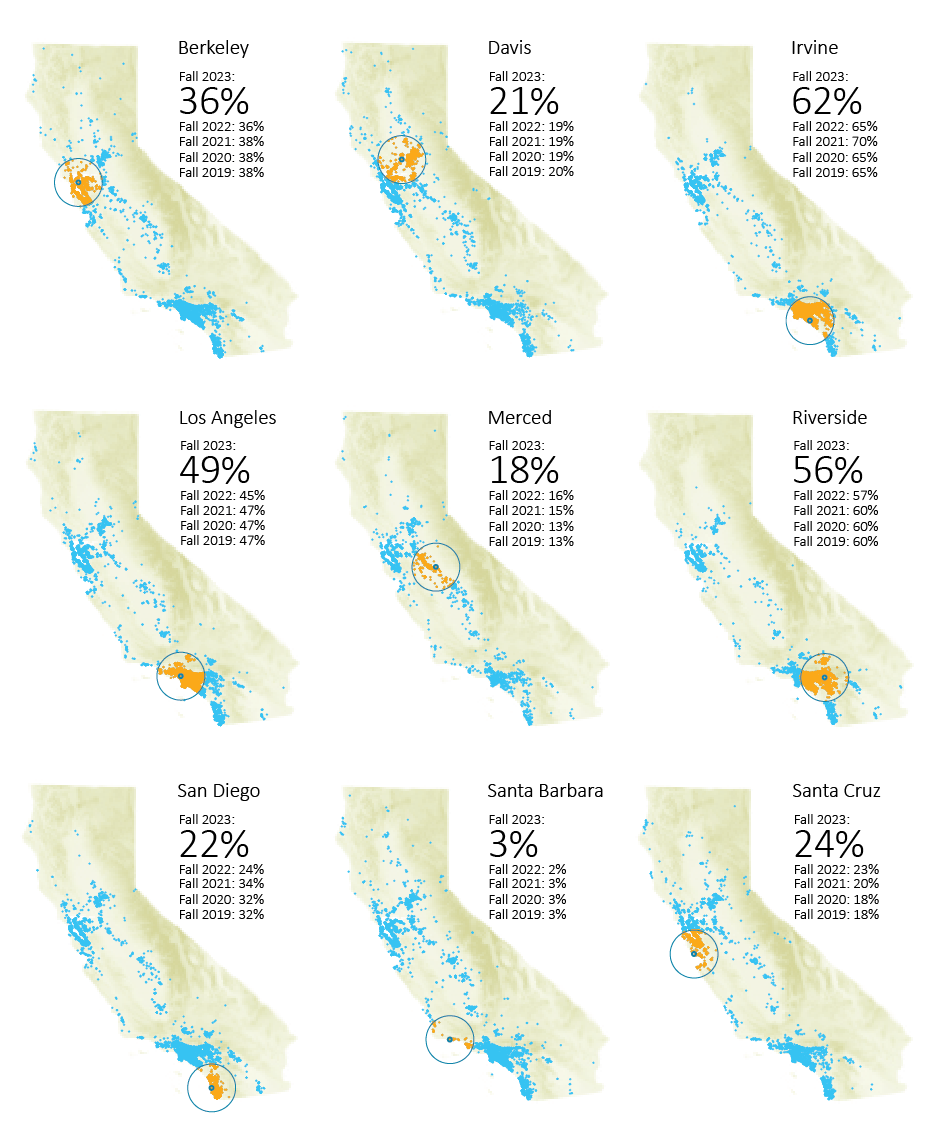
source: UC Data Warehouse and UC Corporate Student System.
Note: California residents are defined here as those with permanent addresses in California.
Local area enrollment rates for transfers are higher than for freshmen, with 47 percent enrolling at a UC campus within 50 miles of their homes.
1.4.4 Percentage of new California resident transfer enrollees whose home is within a 50-mile radius of their campus, UC campuses, Fall 2023

source: UC Data Warehouse and UC Corporate Student System.
Note: California residents are defined here as those with permanent addresses in California.
















